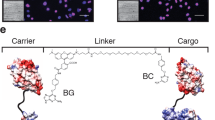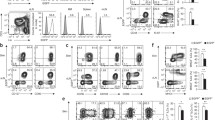Abstract
Chemokines are a family of small, secreted proteins that function in leukocyte and tumor cell trafficking and recruiting. CC chemokine ligand 21 (CCL21)/secondary lymphoid chemokine (SLC) belongs to the inflammatory subgroup of chemokines and is expressed by stromal cells in the T-cell-rich zones of peripheral lymph nodes, afferent lymphatic endothelial cells and high endothelial venules. CCR7 (both in human and mouse) and CXCR3 (in mouse) are expressed by the most potent antigen-presenting cells (dendritic cells), naïve/central memory, and effector T cells, respectively. Inflammation in the skin can induce expression of CCL21 which is subsequently drained into loco-regional lymph nodes responsible for co-localization of antigen-presenting cells and T lymphocytes, a prerequisite for induction of adaptive immune responses. Here, skin functions as a remote control for induction of targeted cell migration in vivo. This chapter describes Gene Gun administration of plasmid DNA expressing functionally active CCL21 (as an example of a chemokine) into the skin in mice and subsequent functional evaluation of the transgene expression in vivo.
Access this chapter
Tax calculation will be finalised at checkout
Purchases are for personal use only
Similar content being viewed by others
References
Rossi D, Zlotnik A (2000) The biology of chemokines and their receptors. Annu Rev Immunol 18:217–242
Colditz IG et al (2007) Chemokines at large: in-vivo mechanisms of their transport, presentation and clearance. Thromb Haemost 97:688–693
Ebert LM, Schaerli P, Moser B (2005) Chemokine-mediated control of T cell traffic in lymphoid and peripheral tissues. Mol Immunol 42:799–809
Stein JV et al (2000) The CC chemokine thymus-derived chemotactic agent 4 (TCA-4, secondary lymphoid tissue chemokine, 6Ckine, exodus-2) triggers lymphocyte function-associated antigen 1-mediated arrest of rolling T lymphocytes in peripheral lymph node high endothelial venules. J Exp Med 191:61–76
Stoecklinger A et al (2011) Langerin+ dermal dendritic cells are critical for CD8+ T cell activation and IgH gamma-1 class switching in response to gene gun vaccines. J Immunol 186:1377–1383
Nagao K et al (2009) Murine epidermal Langerhans cells and langerin-expressing dermal dendritic cells are unrelated and exhibit distinct functions. Proc Natl Acad Sci USA 106:3312–3317
Jalili A et al (2010) Induction of targeted cell migration by cutaneous administration of a DNA vector encoding a biologically active chemokine CCL21. J Invest Dermatol 130:1611–1623
Gunn MD et al (1999) Mice lacking expression of secondary lymphoid organ chemokine have defects in lymphocyte homing and dendritic cell localization. J Exp Med 189:451–460
Author information
Authors and Affiliations
Corresponding author
Editor information
Editors and Affiliations
Rights and permissions
Copyright information
© 2013 Springer Science+Business Media, LLC
About this protocol
Cite this protocol
Jalili, A. (2013). Chemokine Overexpression in the Skin by Biolistic DNA Delivery. In: Sudowe, S., Reske-Kunz, A. (eds) Biolistic DNA Delivery. Methods in Molecular Biology, vol 940. Humana Press, Totowa, NJ. https://doi.org/10.1007/978-1-62703-110-3_15
Download citation
DOI: https://doi.org/10.1007/978-1-62703-110-3_15
Published:
Publisher Name: Humana Press, Totowa, NJ
Print ISBN: 978-1-62703-109-7
Online ISBN: 978-1-62703-110-3
eBook Packages: Springer Protocols




